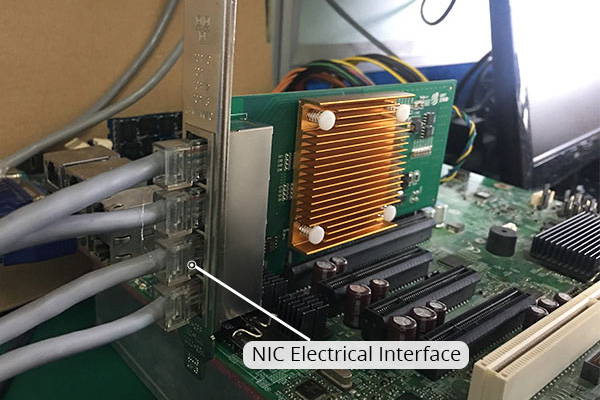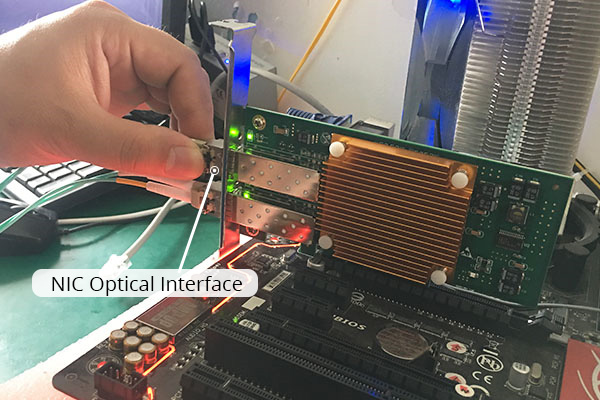Network Interface Card (NIC) Guide - Definition, Types and Functions
What Is a Network Interface Card?
The network interface card (NIC), also known as a network adapter card and network interface controller, is a hardware component that allows devices like computers or servers to communicate with computer networks. The network interface card generally appears like a circuit board or chip.
Early on, the NIC card was inserted into the computer bus in the form of an expansion card. Later, with the lower price and widespread use of Ethernet, most new computers have pre-integrated a network interface on the motherboard. It will no longer require an individual NIC card unless multiple interfaces or other types of networks are needed.
The purpose of NIC is to connect your computer to a LAN network (Local Area Network) over a cable or wireless. It provides physical layer access to communicate with the data link layer (Ethernet or WiFi) so that computers can communicate on the same LAN network or even communicate over large-scale networks through Internet Protocol (IP).

Network Interface Card with Dual SFP Interface
Network Interface Card Function
The number of chips on the network interface card is decreasing for the reason of increasing integration. Although there are many kinds of network cards produced by various manufacturers, their functions are similar. Then, what does a nic do? What is the function of a network interface card? How does it work?
Data Encapsulation
In the encapsulation process, the data can be seen as a package, the frame header and frame end are the wrappings of the package. Network interface card encapsulates the computer data as frames by adding a frame header and frame end, then sends the data to networks through network transmission media. For wired networks, the general transmission media is copper cable or optical fiber, whereas electromagnetic waves for wireless WLAN.
Data Unpacking
When receiving the data frames transmitted from other network devices, the network interface card re-groups those data frames into data by removing the frame header and frame end, then transmits the data to the computer.
Link Management
If the network interface card receives an error data frame, it will discard the error frame independently and not inform the computer. On the contrary, if receiving a correct frame, it will notify the computer and deliver it to the network layer of the protocol stack. When the computer is going to send an IP data packet, the data will be delivered to the network interface card through the protocol stack and sent to LAN after assembling into a frame.
The other important manifestation of the link management function is checking whether the link status is in an idle state. Since Ethernet is a shared link, when you transmit data, conflicts will occur if anybody else is using the link in the meantime.
The link management function is mainly realized through the CSMA/CD (Carrier Sense Multiple Access with collision detection) protocol.
Data Encoding and Decoding
Data transmission must be carried on a physical transmission medium. In practice, the signals transmitted are electrical signals or optical signals. The coding and decoding function is mainly reflected in transforming the data into electrical signals or optical signals by using the coding method of Manchester code.
Different Types of Interface Cards
Bus Types Based Classification
Based on different bus types, network interface cards are mainly four categories, PCI, PCIe, USB, ISA.
ISA and PCI types of NIC - As Early-stage types of NIC, they have been phased out of the market.
USB Type of NIC - Mainly applied in the consumer electronics area.
PCIe Type of NIC - Mainly applied in industrial areas and servers. Compared with the early PCI interface card, it supports a much higher transmission data rate.
Network Interface Based Classification
Based on different types of network interfaces, the network interface card mainly consists of optical interfaces (SC, LC, etc. )and electrical interfaces (RJ45).
Electrical Interface NIC Card - Transmitting electrical signals over copper twisted-pair cables. The max distance reaches up to 100 meters.
Optical Interface NIC Card - Transmitting optical signals over fiber optic cables and optical transceivers. The max distance reaches up to hundreds of meters on a multimode system and thousands of meters on a single-mode system.

Electrical Interface NIC Card

Optical Interface NIC Card
Transmission Data Rate Based Classification
According to transmission data rate, there are network interface cards of 100M, 1000M, 2.5G, 5G, 10G, 25G, 40G, 100G, 200G, etc.
Transmission Media Based Classification
Based on different transmission media, the network interface card can be divided into two categories, wired NIC card, and wireless nic card.
Wired NIC card - Using physical optical fiber cable or copper cable as transmission media to connect to networks.
Wireless NIC card - Compared with wired NIC card, wireless NIC card uses wireless technology to replace cables. To connect with a wireless local area network (WLAN), the wireless NIC card must work with the wireless router or wireless AP (Access Point). The wireless NIC can be seen as a transmitter while the wireless router or AP is like a receiver.
Wireless network cards are mainly divided into internal and external wireless NIC cards. Internal integrated wireless NIC cards commonly exist in laptops and smartphones. USB and PCI/PCIe wireless NIC cards are the most common external wireless NIC cards, they come in handy when your laptop wireless NIC is broken or your desktop computer needs to connect to a wireless network.
Application Based Classification
According to different levels of NIC card application requirements, network interface cards can be divided into server NIC and PC NIC.
PC NIC Card - Used to connect PC to LAN. One NIC card is enough for the ordinary PC.
Server NIC Card - Used to connect the server to network devices like switches. Compared with PC NIC, server NIC has higher requirements for data rate, CPU utilization, stability, and security. Generally, two or more server NIC cards are required for a server.
At last, QSFPTEK offers a series products of NIC, like 1G, 10G, 25G, 40G, 100G network interface cards. Feel free to contact us!










